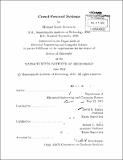Crowd-powered systems
Author(s)
Bernstein, Michael Scott
DownloadFull printable version (29.31Mb)
Other Contributors
Massachusetts Institute of Technology. Dept. of Electrical Engineering and Computer Science.
Advisor
David R. Karger and Robert C. Miller.
Terms of use
Metadata
Show full item recordAbstract
Crowd-powered systems combine computation with human intelligence, drawn from large groups of people connecting and coordinating online. These hybrid systems enable applications and experiences that neither crowds nor computation could support alone. Unfortunately, crowd work is error-prone and slow, making it difficult to incorporate crowds as first-order building blocks in software systems. I introduce computational techniques that decompose complex tasks into simpler, verifiable steps to improve quality, and optimize work to return results in seconds. These techniques develop crowdsourcing as a platform so that it is reliable and responsive enough to be used in interactive systems. This thesis develops these ideas through a series of crowd-powered systems. The first, Soylent, is a word processor that uses paid micro-contributions to aid writing tasks such as text shortening and proofreading. Using Soylent is like having access to an entire editorial staff as you write. The second system, Adrenaline, is a camera that uses crowds to help amateur photographers capture the exact right moment for a photo. It finds the best smile and catches subjects in mid-air jumps, all in realtime. Moving beyond generic knowledge and paid crowds, I introduce techniques to motivate a social network that has specific expertise, and techniques to data mine crowd activity traces in support of a large number of uncommon user goals. These systems point to a future where social and crowd intelligence are central elements of interaction, software, and computation.
Description
Thesis (Ph. D.)--Massachusetts Institute of Technology, Dept. of Electrical Engineering and Computer Science, 2012. Cataloged from PDF version of thesis. Includes bibliographical references (p. 217-237).
Date issued
2012Department
Massachusetts Institute of Technology. Department of Electrical Engineering and Computer SciencePublisher
Massachusetts Institute of Technology
Keywords
Electrical Engineering and Computer Science.